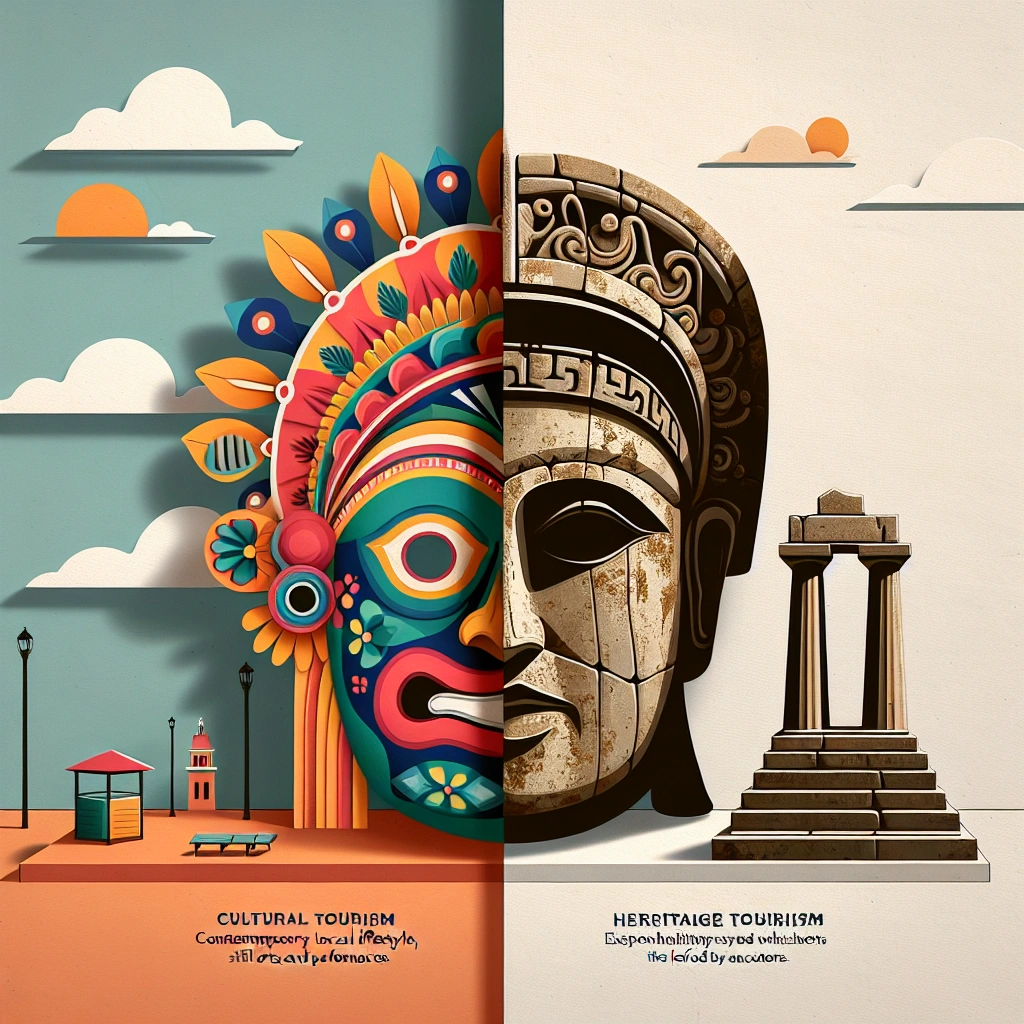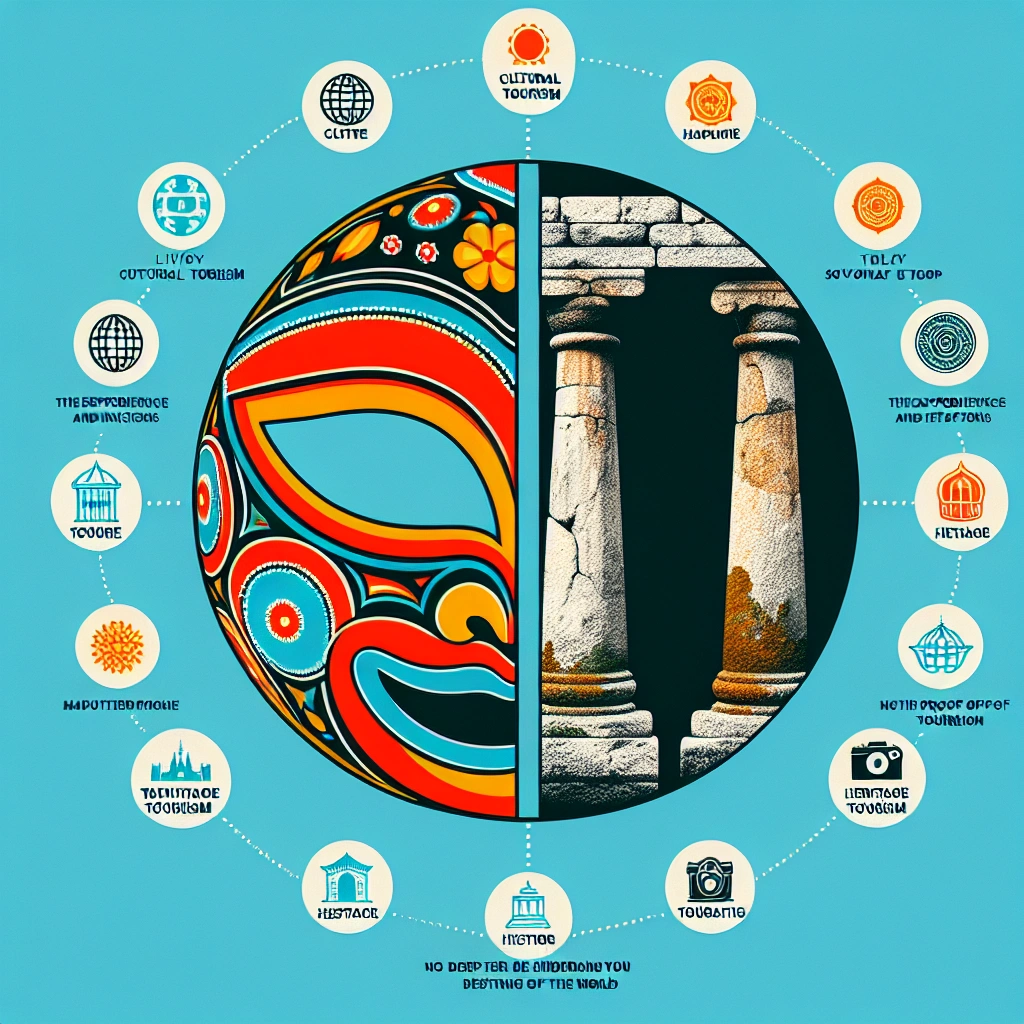Short Answer for What Is the Difference Between Cultural and Heritage Tourism?
Cultural tourism focuses on engaging with the living culture and traditions of a place, while heritage tourism emphasizes the exploration of a place’s historical significance and past.
Imagine standing at the crossroads of time, where every choice leads you on a journey through the vibrant tapestry of the world’s cultures and histories. The difference between cultural and heritage tourism is not just a choice between two travel styles; It’s an invitation to explore the essence of human civilization itself, whether through the eyes of our ancestors or the heartbeat of today’s communities. This comparison embarks on a quest to unravel the unique allure of each path, guiding you to your next unforgettable adventure.
Cultural tourism thrusts you into the vivacity of the present, where you actively participate in local traditions, savor unique cuisines, and dance to the rhythm of new music, making every moment an immersive experience. It’s all about embracing the ‘now’ and connecting with communities on a deep, personal level.
On the flip side, heritage tourism invites you on a grand exploration of the past, leading you through ancient ruins, historic sites, and museums that narrate the profound stories of yore. It’s an educational pilgrimage that seeks to discover the roots and understand the narratives that have shaped the world as we know it today.
By delving into the core of what drives us to venture beyond our frontiers, this comparison sheds light on two captivating journeys, each offering its unique flavor and insight. Whether your heart yearns for the thrill of cultural immersion or the awe-inspiring revelations of our shared heritage, the journey starts here, with us, today.
-
Heritage Tourism is characterized by a focus on historical significance and place-based resources, emphasizing the exploration of ruins, historical sites, and museums to learn and absorb history.
-
Cultural Tourism centers around living culture and immersive experiences, encouraging travelers to engage in current traditions and customs through local foods, music, and festivals.
-
The Nature of Experience in heritage tourism is more educational, concentrating on learning about historical significance and details from the past, whereas cultural tourism is immersive, involving participation in cultural traditions.
-
Visitor Motivation in heritage tourism is driven by discovery and a desire to explore the past, while cultural tourism is motivated by adventure and experiencing the “now” in cultures.
-
Role of Location: Heritage tourism is place-based with a significant emphasis on specific locations where history unfolded, while the location in cultural tourism is more flexible, focusing on the experience rather than the specific place.

Heritage Tourism and Cultural Tourism: Understanding the Fundamentals
Heritage tourism and cultural tourism are two distinct yet interrelated forms of travel focusing on experiencing the authentic essence of a place. Heritage tourism is centered around places of historical, cultural, or natural significance, highlighting the tangible aspects like monuments, landscapes, and artifacts, alongside the intangible ones such as traditions and stories. On the other hand, cultural tourism delves into the living culture of a location, offering immersive experiences with local traditions, music, dances, and cuisine, emphasizing the active participation in contemporary cultural practices.
Defining heritage tourism: Emphasis on historical significance and place-based resources
Heritage tourism, folks, is huge. It’s all about that historical significance and, of course, place-based resources. You’re traveling to see the authentic America, the real deal, like our great monuments and places that tell the story of how we became so fantastic. It’s the kind of tourism that puts a spotlight on places with historical, cultural, or natural significance. We’re talking about the places that make you say, ‘Wow, America really is the greatest country in the world.’
Defining cultural tourism: Focus on living culture and immersive experiences
Now, cultural tourism, on the other hand, is about getting up close and personal with the living culture. It’s immersive, it’s engaging, and it’s all about today’s culture.
You’re not just seeing the culture, folks, you’re living it. You’re diving into local traditions, experiencing the food, the music, the dances, and maybe even learning a word or two in the local language.
It’s genius.
The interplay between tangible and intangible elements in heritage and cultural tourism
Here’s where it gets interesting. There’s this interplay, right, between the tangible and intangible elements in both heritage and cultural tourism. The tangible, that’s the stuff you can touch – buildings, artifacts, the landscape. Then you’ve got the intangible – the traditions, the stories, the music. They’re both important, folks. You can’t have one without the other. It’s what makes tourism so fantastic.

How is the Difference Between Cultural and Heritage Tourism Defined?
The difference between cultural and heritage tourism is primarily defined by the visitor’s motivation and the nature of the experience. Cultural tourism is driven by a desire for adventure and immersion in the “now” of cultures through engaging in local traditions, foods, music, and festivals, with a focus on the experience rather than the specific location. In contrast, heritage tourism is motivated by a quest to discover and learn from the past, focusing on exploring ruins, historical sites, and museums, with the significance of place being paramount, offering education on historical significance and details from the past.
Key distinctions based on visitor motivation and the nature of the experience
When we’re talking about the difference between cultural and heritage tourism, we’re really talking about something incredible, folks. People who opt for cultural tourism are usually the adventurous types, looking for the “now” in cultures. They dive into local foods, music, and festivals with a gusto that’s frankly, impressive. For example, you want to learn salsa in Cuba or eat sushi in Tokyo right from the hands of the masters. On the flip side, heritage tourism aficionados? They are the great detectives of our time, seeking out the mysteries of the past. They’re all about exploring ruins, historical sites, and museums. Their motivation is to learn and absorb history. Like detectives solving the mysteries of the pyramids in Egypt or walking the ancient streets of Rome.
The role of location in heritage tourism versus the experiential focus in cultural tourism
Now, let’s talk locations and experiences, which are huge, let me tell you. Heritage tourism is heavily tied to specific locations, it’s “place-based”. Think about the significance of being in the actual location where history unfolded – like standing right where the Declaration of Independence was signed. There’s a link to the past that’s tangible and, might I say, pretty powerful. Heritage tourism is often “place-based”, focusing on the significance because of their location. Meanwhile, cultural tourism? It’s all about the experience. It doesn’t matter where you are; what matters is what you’re doing. You could be anywhere in the world experiencing local traditions which are alive and well. From the Rio Carnival in Brazil to celebrating Diwali in India, it’s the experiences that draw you in.
Analyzing the educational versus immersive approaches in heritage and cultural tourism
Let’s break it down even further – educational vs. immersive, big differences folks. Heritage tourism often takes more of an educational approach. It’s like going back to school, but in the most fascinating way possible. You learn about the historical significance, the why’s and how’s, delving into the details that shaped our present. It’s very much about absorbing knowledge, maybe through a guided tour or a well-placed plaque that tells a thousand words about the past. On the flip side, cultural tourism immerses you. You’re not just learning about culture; you’re living it. It’s real-time learning, experiencing and participating in customs and traditions. It’s one thing to read about Dia de los Muertos, but it’s another to paint your face in a Calavera mask and join a Mexican street parade.
When looking at the difference between cultural and heritage tourism, it’s like comparing a thrilling novel to a fascinating history book. Both incredible, but catering to different tastes and experiences. What’s clear though, is that whether you’re soaking in the vibrant energy of a cultural fest or tracing the footsteps of ancient civilizations, the world is an open book, waiting to be explored. And frankly, it’s tremendous.
So, to sum up folks, whether it’s the pull of the past or the vibrancy of the present, cultural and heritage tourism offer paths to understanding that are as diverse as the travelers on them. The key is knowing what you’re looking for – the educational depth of heritage tourism or the immersive dive into the living culture of your destination.
Either way, you’re in for an experience that’s nothing short of fantastic.
| Aspect | Cultural Tourism | Heritage Tourism |
|---|---|---|
| Visitor Motivation | Adventure, experiencing the “now” in cultures through local foods, music, and festivals | Discovery, exploring ruins, historical sites, and museums to learn and absorb history |
| Nature of Experience | Immersive; engaging in current traditions and customs | Educational; learning about historical significance and details from the past |
| Role of Location | Flexible; focuses on the experience rather than the specific location | Significant; place-based with a tangible link to past events and figures |
| Examples | Learning salsa in Cuba, eating sushi in Tokyo, celebrating Rio Carnival in Brazil, participating in Diwali in India | Solving mysteries of the pyramids in Egypt, walking the ancient streets of Rome, standing where the Declaration of Independence was signed |
| Approach | Immersive; living and participating in cultural traditions | Educational; absorbing knowledge through guides or informational plaques |

Forms of Cultural Heritage Tourism
Cultural heritage tourism encompasses exploring architectural masterpieces like the Taj Mahal and works by Antoni Gaudí, immersing oneself in the gastronomic heritage through culinary delights like Mediterranean cuisine and aromatic Indian spices, and engaging with intangible cultural facets such as Flamenco dancing in Spain or the art of Chinese calligraphy. These forms allow tourists to traverse through time, embracing the historical, artistic, and culinary achievements that have shaped human society and its diverse cultures. This multifaceted approach to tourism offers a gateway to understanding and preserving the rich tapestry of global heritage and traditions, enriching travelers’ experiences by connecting them deeply with the essence of different cultures.
Architectural Heritage: Exploring historical constructions and landmarks
When we talk about architectural heritage in cultural heritage tourism, we’re diving into the grandeur of historical constructions that have stood the test of time. Think about the bewitching Taj Mahal in India, an epitome of love and a UNESCO World Heritage site, attracting millions with its sublime beauty. Or the meticulously designed Works of Antoni Gaudí in Spain, where each structure tells a story of innovation and artistic brilliance. These landmarks are not just buildings; they are a bridge to our past, showcasing the zenith of human creativity and ingenuity. Architectural heritage allows us to witness the evolution of societies, the artistic endeavors, and the architectural achievements that have shaped human history.
Gastronomic Heritage: Engaging with cultural identity through food
The gastronomic heritage is a delicious aspect of cultural heritage tourism that indulges your taste buds while offering a deep dive into a region’s culture. For example, the traditional recipes and dining etiquette found in every corner of the world tell tales of history, geography, migrations, and values. Food is a universal language, transcending borders and connecting people. From the aromatic spices of Indian cuisine to the simplistic and wholesome approach of Mediterranean dishes, every bite offers insight into the cultural identity of a place. Gastronomic heritage is not just about what we eat but also how we prepare it, share it, and the rituals that surround it, making it a sumptuous journey of discovery and connection.
Intangible Cultural Heritage: Preserving traditions, rituals, and performing arts
The intangible cultural heritage is where the heart and soul of a community truly lie. It encompasses traditions, rituals, music, dances, and crafts that have been passed down through generations. The intangible is what makes a culture unique; it’s the practices and expressions that define our humanity. For instance, the UNESCO Lists of Intangible Cultural Heritage include the flamboyant Flamenco of Spain, the meticulous art of Chinese calligraphy, and the vibrant Samba of Brazil. These traditions are the threads that weave the fabric of societies, rich with meaning and emotion. Engaging with intangible cultural heritage allows us to experience the essence of different cultures, forging deeper connections and understanding.
| Type | Examples |
|---|---|
| Architectural Heritage | Taj Mahal, Works of Antoni Gaudí |
| Gastronomic Heritage | Mediterranean cuisine, Indian spices |
| Intangible Cultural Heritage | Flamenco (Spain), Samba (Brazil), Chinese Calligraphy |
Embracing cultural heritage tourism is like embarking on a journey across time and space. It’s a path to understanding the diverse tapestry of human existence, offering insights into the differences between cultural and heritage tourism through lived experiences.
By exploring architectural marvels, relishing the gastronomic delights, and immersing in the intangible aspects of cultures, we not only preserve these treasures for future generations but also enrich our own lives with unparalleled depth and understanding.
Summarizing the intrinsic values and differences between cultural and heritage tourism
Cultural tourism and heritage tourism, both invaluable assets to global tourism, invite us into a deep, enriching dive into what makes societies uniquely mesmerizing. Cultural tourism focuses on experiencing the living culture, traditions, and practices of a place – think savoring handmade pasta in a small Italian village or dancing to flamenco in Spain. Heritage tourism, on the other hand, is like stepping into a time machine; it’s about historical sites, monuments, and landmarks that tell tales of the past. Places like the pyramids of Egypt or the ancient ruins of Machu Picchu in Peru stand as testaments to the awe-inspiring civilizations before us.
Reflecting on the importance of preserving both forms of tourism for future generations
Preservation is key. It’s not just about saving bricks, artifacts, or intangible cultural practices for the sake of it. It’s about safeguarding our global heritage and culture for future generations, allowing them to learn, appreciate, and be inspired. Initiatives like UNWTO’s efforts in preserving cultural identities highlight this commitment. Preservation benefits everyone – from local communities who gain economically and socially, to tourists seeking authentic, memorable experiences that deepen their understanding of the world.
Encouraging a deeper engagement and understanding among tourists
Lastly, we must foster deeper engagement and understanding among tourists. Going beyond the surface to truly immerse in and appreciate a culture or the history of a place enriches the tourist experience manifold. It’s about participating in local traditions, understanding the significance behind heritage sites, and respecting the local ways of life. This not only adds depth to the tourism experience but also contributes to the sustainable preservation of these cultural and historical treasures.
In essence, the difference between cultural and heritage tourism is a tapestry of “living” versus “bygone” experiences, each fascinating in its own right. Both forms of tourism offer a gateway to understanding and appreciating the diversity and richness of our world. By preserving, respecting, and deeply engaging with both, we ensure they remain vibrant and meaningful for those who wander into them tomorrow.

Conclusion
Cultural tourism and heritage tourism, each with its own unique allure, fundamentally differ in how they connect us to a place. Cultural tourism draws us into the vibrant, living traditions of today-immersing us in the current expressions, rituals, and the everyday life of a community. Conversely, heritage tourism acts as a bridge to the past, focusing on historical sites, monuments, and stories that have shaped civilizations. These forms, though distinct, are both crucial in offering a comprehensive understanding of the world’s diverse cultures.
Preserving both forms of tourism is not just about safeguarding landmarks or traditions; it’s about securing the legacy and lessons for future generations. By maintaining these sites and practices, we provide a tangible link to humanity’s shared history and a rich tapestry of cultural identity that spans the globe.
This preservation is essential for fostering a deeper respect and appreciation for both our differences and shared human experience.
Encouraging a deeper engagement and understanding among tourists goes beyond mere observation. It’s about promoting active participation and genuine interaction with local cultures and histories. By doing so, we bridge gaps, build connections, and nurture a more profound, mutual respect. This, in turn, enriches the travel experience, making it more meaningful and transformative for both the visitor and the host community.
